41 variable labels syntax spss
Variable Labels - Ibm VARIABLE LABELSassigns descriptive labels to variables in the active dataset. VARIABLE LABELS varname 'label' [/varname...] Example VARIABLE LABELS YRHIRED 'YEAR OF FIRST HIRING'. This command takes effect immediately. See the topic Command Orderfor more information. Variable labels can also be specified from the Variable Viewtab. Assign variable and value labels of a given variable to other variables ... DEFINE !applab (!POS=!TOKENS (1) /tovars=!CMDEND) * Apply variable and value labels of VAR1 to VARLIST. * rlevesque@videotron.ca. RENAME VARIABLES (!1=model). ! LET !filenam=!QUOTE (!CONCAT ('c:\\temp\\dictionary',!1,'.sav')) SAVE OUTFILE=!filenam /KEEP=model. RENAME VARIABLES (model=!1). ! DO !var !IN (!tovars) RENAME VARIABLES (!var=model).
SPSS Tutorials: Defining Variables - Kent State University 22.07.2022 · Written and illustrated tutorials for the statistical software SPSS. Variable definitions include a variable's name, type, label, formatting, role, and other attributes. This tutorial shows how to define variable properties in SPSS, especially custom missing values and value labels for categorical variables.

Variable labels syntax spss
Overview (VARIABLE LABELS command) - IBM Syntax Rules Labels can be added to any previously defined variable. It is not necessary to enter labels for all variables in the active dataset. Each variable label must be enclosed in quotes. Variable labels can contain any characters, including blanks. › spss-do-if-commandSPSS DO IF - Change Variables for a Selection of Cases SPSS DO IF – Simple Tutorial By Ruben Geert van den Berg under SPSS A-Z. SPSS transformations between DO IF ... and END IF are applied only to cases (rows of data) that satisfy one or more conditions. In many cases, IF is a faster way to accomplish the same results. SPSS Do If Example. Say we'd like to convert people's monthly income into ... SPSS Variable and Value Labels Editing Tool - SPSS tutorials ALL for specifiying all variables in the active dataset. We did just that in the syntax below. *Remove " (proceed" and characters succeeding it from all variable labels. SPSS TUTORIALS CLEAN_LABELS VARIABLES=all FIND=' (proceed' REPLACEBY=' ' /OPTIONS OPERATION=FIOCSUC PROCESS=VARLABS ACTION=RUN.
Variable labels syntax spss. Overview (VALUE LABELS command) - IBM The basic specification is a variable name and the individual values with their assigned labels. Syntax Rules Labels can be assigned to any previously defined variables. It is not necessary to enter value labels for all values for a variable. Each value label must be enclosed in quotes. Using Syntax to Assign 'Variable Labels' and 'Value Labels' in SPSS ... Open a new syntax window by clicking through the following menu path ( see below ): File->New->Syntax. Type the command "VARIABLE LABELS" (be careful of spelling). On the next line (new line not required, but recommended), first type the name of the variable you want to assign a label to (in my example, the variable is "Example1"; see below ). How Do I Change the Variable Name in SPSS Syntax? Enter the data in the SPSS Statistics Data Editor and name the variable "Scores". Click on Transform > Recode Into Different Variables in the top menu. Transfer the variable you want to recode by selected it and pressing the button, and give the new variable a name and label. SPSS Guide: Labeling variables and data values Variable labels can be up to 120 characters long. However, usually far fewer characters are displayed in the output; in most cases, 40-60 characters would be a good choice. You can label several variables with a single VAR LAB command, but variables-plus-labels must be separated by slashes as shown in the example above.
database - Exporting SPSS variable labels - Stack Overflow 1. You can export the variable labels using the DISPLAY DICTIONARY. SPSS syntax. You can also find this in the menu: File -> Display Data File Information -> Working File. A table with the category labels of all variables appears in the output window. You can export the contents of the output window into formats understood by other software ... SPSS Instruction Manual - University of West Georgia The Syntax Editor You can paste your dialog box selections into a Syntax Editor window, where your selections appear in the form of command syntax. Ø Tutorial 2: Starting A SPSS Session 1. Logon to your Polaris account. 2. Select Programs from the Start menu. 3. Select Scientific from the Programs drop down menu. 4. Select SPSS 7.5 from the ... Display Value Labels in SPSS - Easy SPSS Tutorial Quick Steps. Click on tab to display Variable View. Identify your variable, click on its cell in the Values column, and then click on the ellipsis. Enter your first coded numerical value where it says Value, and the label you want associated with that value where it says Label. Press Add, and then repeat for all further numerical values. SPSS - Set Variable Labels with Syntax - SPSS tutorials SPSS Variable Labels Syntax Examples (The test data used by the syntax below are found here .) *1. Modify (or add) a single variable label. variable labels name 'First name of respondent'. *2. Modify (or add) two variable labels in a single command. variable labels birthday 'Birthday of respondent'/married 'Marital status of respondent'.
Labels, Variable Names and Format | Raynald's SPSS Tools Labels, Variable Names and Format. Add (or replace) a character at the beginning of each var names. Add'_99' at the end of every variable names. Apply lab1 as value label to var1 by syntax. Assign same label to many variables. Assign value labels to a vector. Assign variable and value labels of a given variable to other variables. SPSS Tutorials: Using SPSS Syntax - Kent State University 22.07.2022 · In SPSS syntax, placing an asterisk (*) ... If you are a Qualtrics user and have downloaded your "raw" survey data in SPSS format, using syntax to modify variable labels or compute new variables means that you don't have to worry if you lose the SPSS data file you've been working in; you can just re-download the raw data from Qualtrics and rerun your syntax … Writing value labels instead of values | Raynald's SPSS Tools If you wish to *** read the data, you would have to exit SPSS, then you may *** enter SPSS and use the following syntax: data list free file='report data' /caseid (f2) religion (a10) gender (a8). › vrc › assetsSPSS Instruction Manual - University of West Georgia Type: This field describes the type of variable that is being defined. To change this field, click on the Type… button. This will open the Define Variable Type: dialog box. Select the appropriate type of data. When done, click on the Continue button. Variable Label: There are two types of variable labels: 1.
› variable-labels-andVariable Labels and Value Labels in SPSS - The Analysis Factor Variable Labels. The really nice part is SPSS makes Variable Labels easy to use: 1. Mouse over the variable name in the Data View spreadsheet to see the Variable Label. 2. In dialog boxes, lists of variables can be shown with either Variable Names or Variable Labels. Just go to Edit–>Options. In the General tab, choose Display Labels. 3.
Using Syntax to Assign 'Variable Labels' and 'Value Labels' in SPSS Here are the steps to assign value labels (in the same syntax window): Type the command "VALUE LABELS" (be careful of spelling). On the next line (new line not required, but recommended), type the name of the variable you want to assign a value labels to (in my example, the variable is "Example1"; see below). On the next line (new line not required, but recommended), type the number code that ...
Variable and Value Labels in SPSS - Steve Granger Syntax for Labeling or Relabeling Variable Labels Labeling one variable VARIABLE LABELS varname 'Type your variable label here'. e.g., VARIABLE LABELS FPK 'MEAN SCALE SCORE: Follower's political knowledge'. Labeling more than one variable VARIABLE LABELS varname 'Type your variable label here' /varname2 'Type your variable label 2 here'
SPSS Variable and Value Labels: A Quick Tutorial - Alchemer The above two examples works fine however, if we really want to trim down our code, we can use one more short-cut by only using the Value Label command once and then applying the labels to each variable. VALUE LABELS / var503 TO var504 0 'Unchecked' 1 'Checked' / var603 TO var605 1 "Couldn't care less" 2 'Somewhat devoted' 3 "Can't live w/o it!"
syntax - Export SPSS metadata variable labels, value labels, data types ... You can also import the meta data from a SPSS data file. The command for doing so is: APPLY DICTIONARY FROM datafilename.sav /SOURCE VARIABLES = varlist /TARGET VARIABLES = varlist /NEWVARS . You can find the complete information on this in IBM SPSS Statistics 26 Command Syntax Reference, Chapter 15 - APPLY DICTIONARY, p. 167ff HTH. Best Regards
SPSS DO IF - Change Variables for a Selection of Cases SPSS Do If Syntax Example 2 ... The final syntax example demonstrates this by creating a birth decennium variable using XDATE. Next, FREQUENCIES confirms that respondents whose birthday is unknown are not assigned to any birth decennium. SPSS Do If Syntax Example 3 *1. Create birth_decennium variable. do if xdate.year(date_of_birth) lt 1960. compute …
Value labels - IBM You can assign descriptive value labels for each value of a variable. This process is particularly useful if your data file uses numeric codes to represent non-numeric categories (for example, codes of 1 and 2 for male and female ). Value labels are saved with the data file. You do not need to redefine value labels each time you open a data file.
› SPSSTutorial_1SPSS Step-by-Step Tutorial: Part 1 - DataStep SPSS Step-by-Step 3 Table of Contents 1 SPSS Step-by-Step 5 Introduction 5 Installing the Data 6 Installing files from the Internet 6 Installing files from the diskette 6 Introducing the interface 6 The data view 7 The variable view 7 The output view 7 The draft view 10 The syntax view 10 What the heck is a crosstab? 12 2 Entering and modifying ...
define variable labels in a loop for existing variables SPSS 1 Answer. If you have the SPSS Python Integration Package installed you can run a loop in Python. The following code creates the lines variable labels V# "Person #". Where '#' is a number from 1 to 3. BEGIN PROGRAM. import spss for i in range (1, 4): spss.Submit ('variable labels V%s "Person %s".' % (i, i)) END PROGRAM.
Assign same label to many variables | Raynald's SPSS Tools * Apply same label to many variables. * rlevesque@videotron.ca. DATA LIST LIST /var1 c d h. BEGIN DATA END DATA. DEFINE !label (label=!TOKENS (1) /list=!CMDEND) !DO !var !IN (!list). VARIABLE LABEL !var !label. ! DOEND. ! ENDDEFINE. !label label='your label' list=var1 c d h.
libguides.library.kent.edu › SPSS › SyntaxSPSS Tutorials: Using SPSS Syntax - Kent State University Jul 22, 2022 · SPSS Syntax (*.sps) Syntax to add variable labels, value labels, set variable types, and compute several recoded variables used in later tutorials. SAS Syntax (*.sas) Syntax to read the CSV-format sample data and set variable labels and formats/value labels.
› spss-merge-categories-ofSPSS - Merge Categories of Categorical Variable A very decent way to merge our small categories is creating a new variable with RECODE (syntax below, step 1). We'll call this new variable rec_nation which is short for “recoded nation”. Keep in mind that this new variable doesn't come with any variable labels or value labels. We'll therefore apply these ourselves.
Labeling and documenting data | SPSS Learning Modules This module illustrates how to document data sets in a variety of ways, including creating and using value, variable and dataset labels in SPSS, as well as adding notes regarding the data set. ... you need to use the add value labels command. The syntax for the add value labels command is the same as the syntax for the value labels command. 6 ...
libguides.library.kent.edu › SPSS › DefineVariablesSPSS Tutorials: Defining Variables - Kent State University Jul 22, 2022 · Written and illustrated tutorials for the statistical software SPSS. Variable definitions include a variable's name, type, label, formatting, role, and other attributes. This tutorial shows how to define variable properties in SPSS, especially custom missing values and value labels for categorical variables.
pandas.read_sql — pandas 1.4.3 documentation pandas.read_sql¶ pandas. read_sql (sql, con, index_col = None, coerce_float = True, params = None, parse_dates = None, columns = None, chunksize = None) [source] ¶ Read SQL query or database table into a DataFrame. This function is a convenience wrapper around read_sql_table and read_sql_query (for backward compatibility). It will delegate to the specific function …
Rename Variables - Ibm RENAME VARIABLESchanges the names of variables in the active dataset while preserving their original order, values, variable labels, value labels, missing values, and print and write formats. RENAME VARIABLES {(varname=newname) [(varname ...)]} {(varnames=newnames) } This command takes effect immediately.
Set SPSS Variable Names as Labels with Python - SPSS tutorials *Look up all variable labels. begin program python3. import spss for ind in range (spss.GetVariableCount ()): varNam = spss.GetVariableName (ind) varLab = spss.GetVariableLabel (ind) print (varLab) end program. 3. Create Variable Labels with Python If some variable does not have a label yet, Python will return an empty string.
SPSS Step-by-Step Tutorial: Part 1 - DataStep SPSS Step-by-Step 3 Table of Contents 1 SPSS Step-by-Step 5 Introduction 5 Installing the Data 6 Installing files from the Internet 6 Installing files from the diskette 6 Introducing the interface 6 The data view 7 The variable view 7 The output view 7 The draft view 10 The syntax view 10 What the heck is a crosstab? 12 2 Entering and modifying data 13
Variable Labels and Value Labels in SPSS - The Analysis Factor SPSS Variable Labels and Value Labels are two of the great features of its ability to create a code book right in the data set. Using these every time is good data analysis practice.. SPSS doesn’t limit variable names to 8 characters like it used to, but you still can’t use spaces, and it will make coding easier if you keep the variable names short.
SPSS - Merge Categories of Categorical Variable A very decent way to merge our small categories is creating a new variable with RECODE (syntax below, step 1). We'll call this new variable rec_nation which is short for “recoded nation”. Keep in mind that this new variable doesn't come with any variable labels or value labels. We'll therefore apply these ourselves.
SPSS - Clone Variables Tool Note that SPSS has now added a new variable to our data: cjtype as shown below. Except for its name, cjtype is an exact clone of jtype: it has the same. variable type and format; value labels; user missing values; and so on... There's one minor issue with our first example: the syntax we just pasted only runs on SPSS installations with our tool ...
SPSS Syntax 101: Basic Guidelines, Variable and Value Labels — Ben ... You can quickly assign labels to both the variable itself and to its values using the syntax below: variable labels lifesat 'overall satisfaction with life' . value labels lifesat 1 'strongly disagree' 2 'disagree' 3 'neither agree nor disagree' 4 'agree' 5 'strongly agree'. To run this syntax, first copy and paste it into your syntax file.
How to delete one particular value label - Google Groups Hi. The following is only a description of a possible approach: - Suppose you need to completely delete the label for the value 99 of. var1 . - Backup your file. (Work with a copy). - create a new variable (say vallab) containing the value labels. (using Reverse Autorecode.sbs which is available from SPSS as well as.
Add value labels | Raynald's SPSS Tools Add value labels. 'Begin Description 'Purpose: To assign value labels of format mmm yyyy (eg Feb 1997) to a numeric variable 'Assumptions: The numeric variable is in the data editor and contains positive integers 'Inputs: 5 parameters are required, 1) varname, 2)starting month, 3)starting year, 4)direction (1 means ' forward and -1 means ...
SPSS Variable and Value Labels Editing Tool - SPSS tutorials ALL for specifiying all variables in the active dataset. We did just that in the syntax below. *Remove " (proceed" and characters succeeding it from all variable labels. SPSS TUTORIALS CLEAN_LABELS VARIABLES=all FIND=' (proceed' REPLACEBY=' ' /OPTIONS OPERATION=FIOCSUC PROCESS=VARLABS ACTION=RUN.
› spss-do-if-commandSPSS DO IF - Change Variables for a Selection of Cases SPSS DO IF – Simple Tutorial By Ruben Geert van den Berg under SPSS A-Z. SPSS transformations between DO IF ... and END IF are applied only to cases (rows of data) that satisfy one or more conditions. In many cases, IF is a faster way to accomplish the same results. SPSS Do If Example. Say we'd like to convert people's monthly income into ...
Overview (VARIABLE LABELS command) - IBM Syntax Rules Labels can be added to any previously defined variable. It is not necessary to enter labels for all variables in the active dataset. Each variable label must be enclosed in quotes. Variable labels can contain any characters, including blanks.
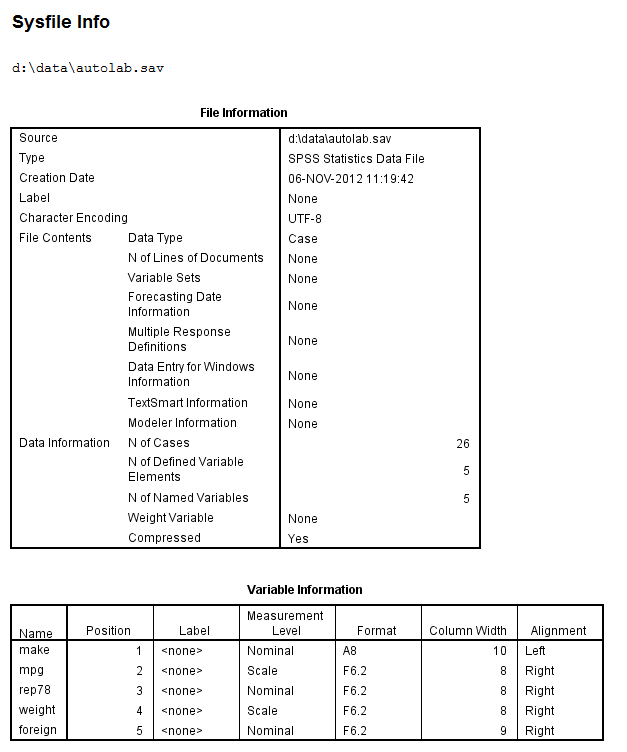


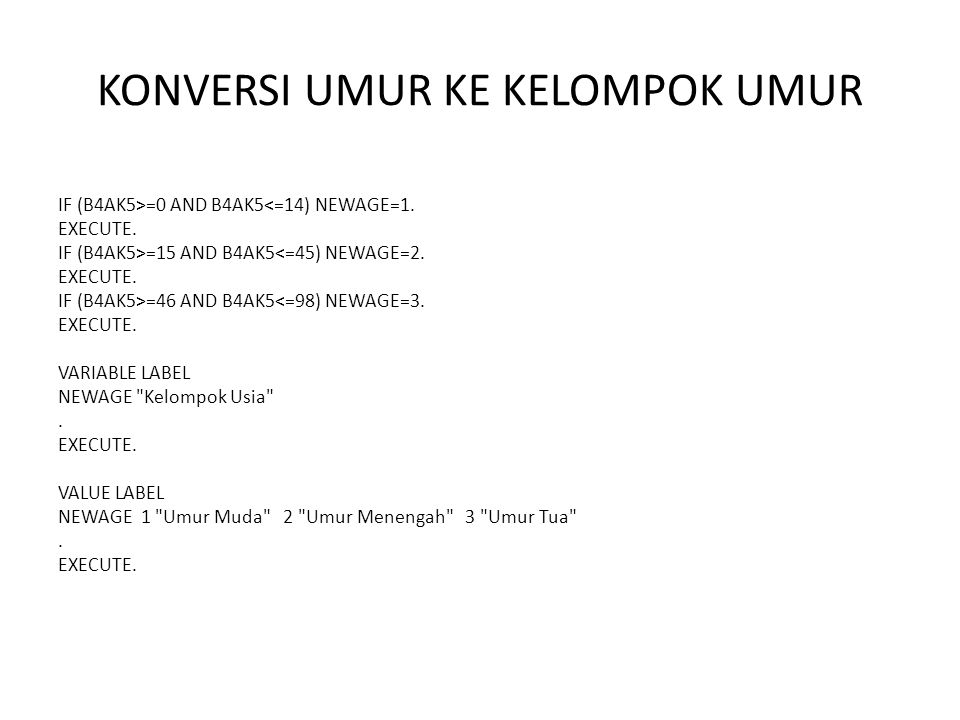
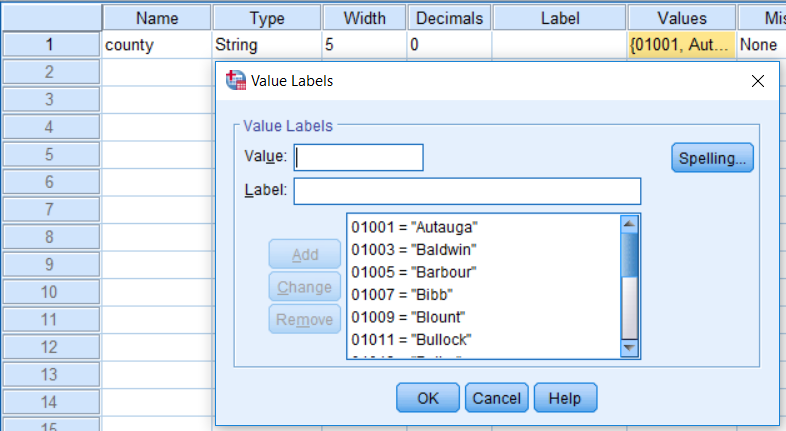
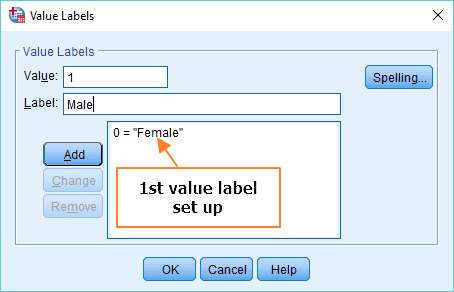


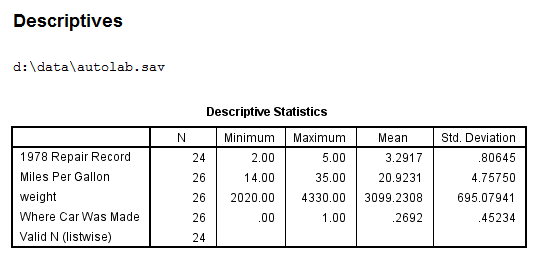

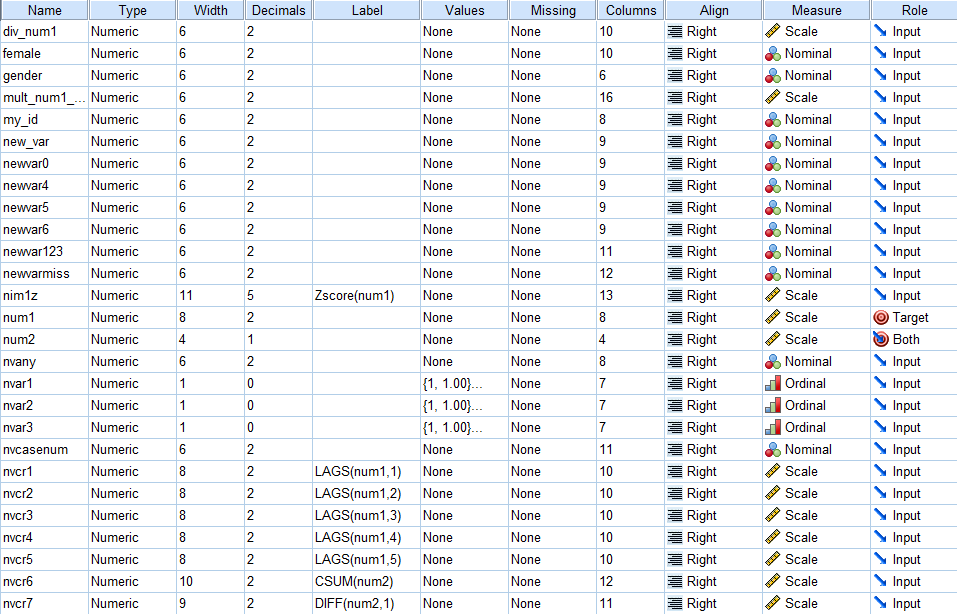
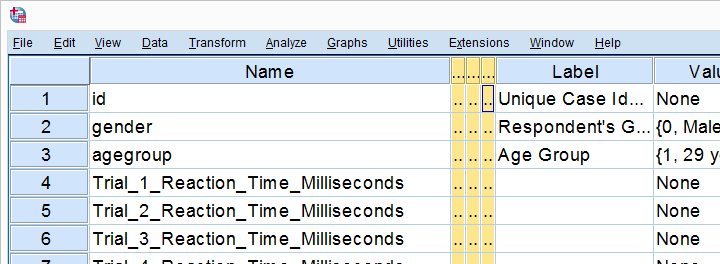
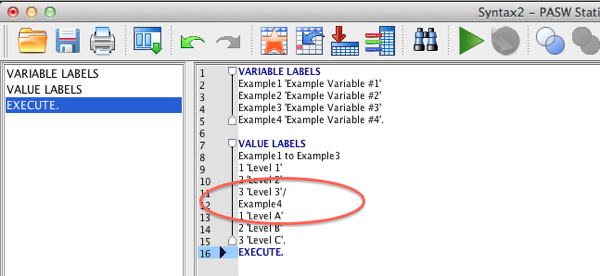
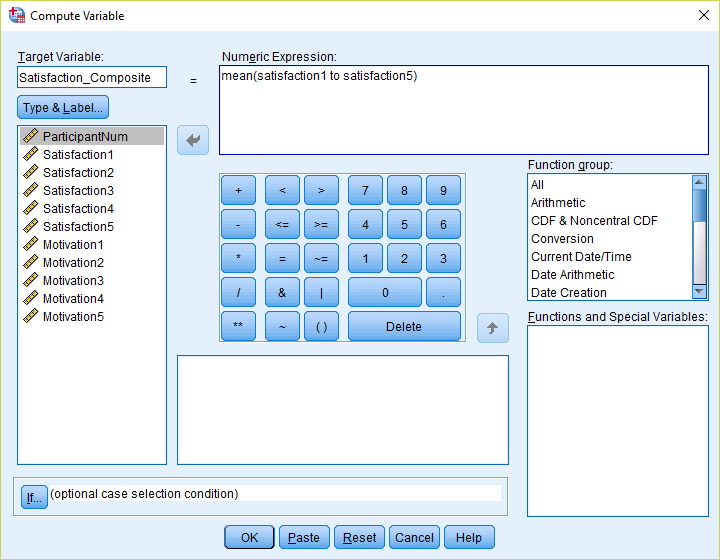

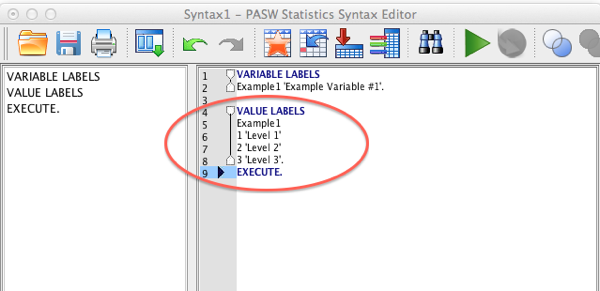





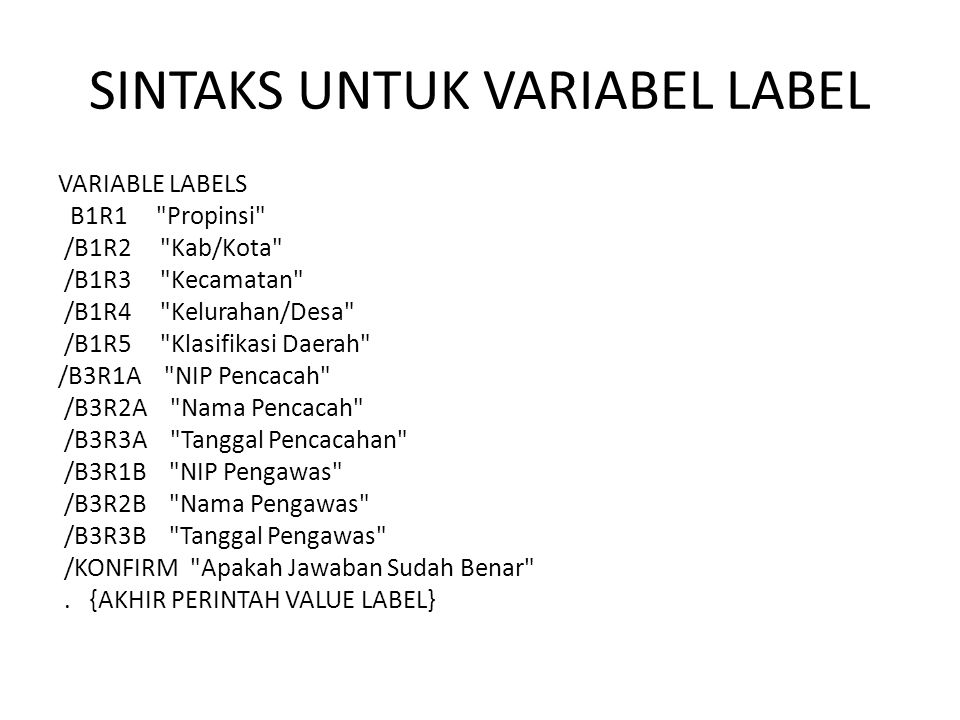


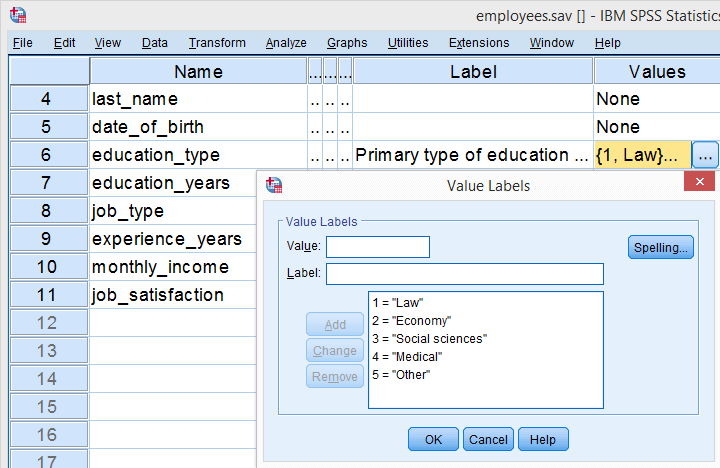
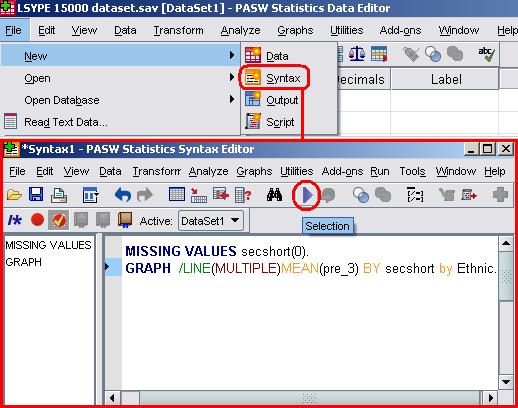
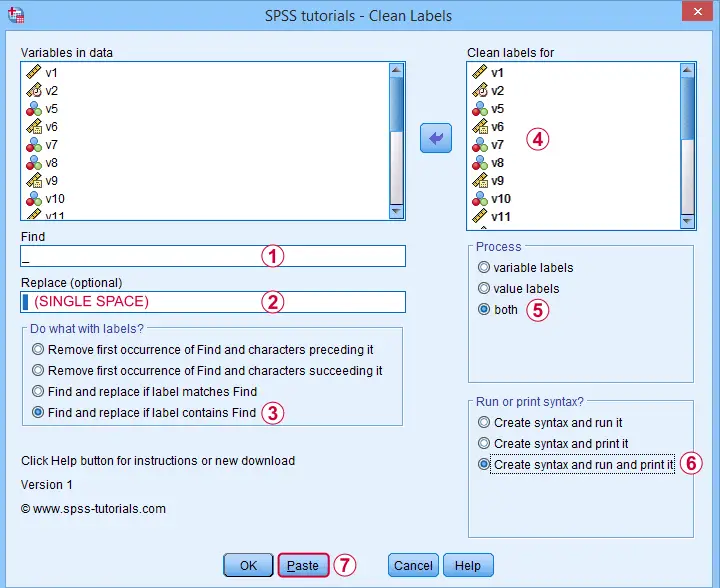

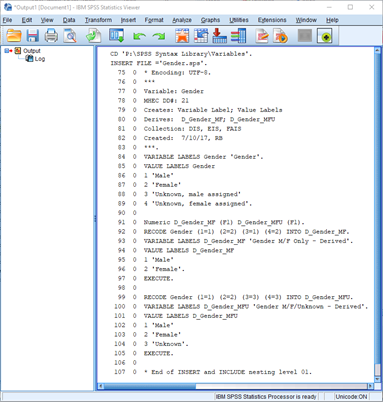



Post a Comment for "41 variable labels syntax spss"